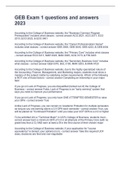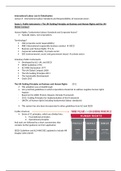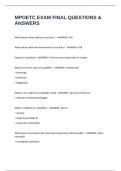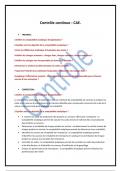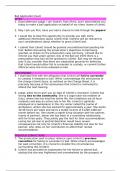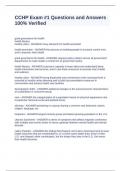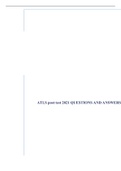FDI, trade & geography – lecture 5-lecture 7
Lecture 5: downsides of international capital mobility: currency
crises
9.2: What are currency crises?
Flexible exchange rates value of exchange rate is determined by
market forces exchange rate fluctuates (i.e. euro vs. US$).
Fixed exchange rates central bank defines target rate and band
around it. Foreign exchange interventions if market rate moves outside of
the band (i.e. Danish krona vs. euro).
Currency crisis strong exchange rate pressure that would result in a
substantial appreciation or depreciation of a currency over a short period
of time.
- = a downside of capital mobility
- Usually in the context of currency depreciation
- Most damaging in fixed exchange rate regimes (agents do not
expect an appreciation or depreciation)
- Must not lead to actual depreciation/appreciation exchange rate
pressure alone sufficient if it forces central bank to substantially
intervene
‘’Archetypical’’ currency crisis:
- Loss of confidence in economy/currency (by investors)
- (Large-scale) sales of domestic financial asset (= speculative attack)
exchange rate pressure
- Central bank tries to fight the attack by:
o Raising interest rates
o Selling foreign reserve assets against local currency
- If measures are not successful: sharp depreciation of the local
currency
Currency crisis indicator captures the extent of exchange rate
pressure based on:
- Change in the exchange rate (forced to adjust fixed exchange rate
because of the speculative attack)
- Change in the short-term interest rate (forced to adjust interest rates
to fight the speculative attack)
- Change in foreign reserve assets (forced to sell/buy foreign reserve
assets to fight the speculative attack)
(Eichengreen, Rose, and Wyplosz, 1995)
- What matters for an event to qualify as a currency crisis is the
amount of exchange rate pressure.
- Not only an actual change in the exchange rate qualifies as a
currency crisis ( successful attack)
- A currency crisis also occurs if a country can defend the fixed
exchange rate by adjusting its interest rates/trading foreign reserve
assets ( unsuccessful attack)
, - Bordo et al. (2001): frequency of currency crisis has increased from
1% before WWI to 7% in the 1990s. Reason: emerging markets,
increased capital mobility)
9.3: Characteristics of currency crises
- Reversal of capital flows (loss of confidence in economy/currency
leads to sell of domestic assets/withdrawal of capital FA decrease)
- Adjustment of current account: CA increase (since CA+FA = 0)
- Increased real value of foreign debt (due to devaluation of currency)
- Reduction in GDP growth (due to higher interest rates, fewer funds
available for domestic investment due to capital outflow, higher real
debt)
9.4: First-generation models of currency crises
Different theories have been developed to explain and understand
currency crises.
1st generation models: crisis due to bad macroeconomic conditions
(‘bad fundamentals’)
2nd generation models: role of investors in triggering a crisis.
1st and 2nd generation model differ along two dimensions:
- Rationale for the crisis: flawed domestic economy vs. purely
speculative actions
- Role of international investors: react to crisis (passive) vs. influence
the outcome of the crisis (active)
First-generation models: overview
- Based on Krugman (1979) and Flood and Garber (1984)
- Key source for the crisis is unsustainable fiscal policy (‘bad
fundamentals’): excessive government spending
- Investors play a passive role
- Devaluation is the only possible outcome
Key elements:
- Increasing money supply is the result of loaning the government and
buying foreign reserve assets: dM = dF + dR
o dM > 0: increase in money supply
o dF > 0: expansionary fiscal policy
o dR > 0: purchase of foreign reserve assets
- The money supply influences the price level:
P = m(M), with dP/dM > 0
an increase in the money supply (dM > 0) leads to inflation dP > 0)
- PPP condition: P = E x P* (P*: foreign price level)
E has to adjust when P changes: inflation (P increases) leads to a
devaluation of the domestic currency (E increases)
First-generation models:
- Government runs a constant budget deficit financed by loans from
the central bank (dF > 0)
Lecture 5: downsides of international capital mobility: currency
crises
9.2: What are currency crises?
Flexible exchange rates value of exchange rate is determined by
market forces exchange rate fluctuates (i.e. euro vs. US$).
Fixed exchange rates central bank defines target rate and band
around it. Foreign exchange interventions if market rate moves outside of
the band (i.e. Danish krona vs. euro).
Currency crisis strong exchange rate pressure that would result in a
substantial appreciation or depreciation of a currency over a short period
of time.
- = a downside of capital mobility
- Usually in the context of currency depreciation
- Most damaging in fixed exchange rate regimes (agents do not
expect an appreciation or depreciation)
- Must not lead to actual depreciation/appreciation exchange rate
pressure alone sufficient if it forces central bank to substantially
intervene
‘’Archetypical’’ currency crisis:
- Loss of confidence in economy/currency (by investors)
- (Large-scale) sales of domestic financial asset (= speculative attack)
exchange rate pressure
- Central bank tries to fight the attack by:
o Raising interest rates
o Selling foreign reserve assets against local currency
- If measures are not successful: sharp depreciation of the local
currency
Currency crisis indicator captures the extent of exchange rate
pressure based on:
- Change in the exchange rate (forced to adjust fixed exchange rate
because of the speculative attack)
- Change in the short-term interest rate (forced to adjust interest rates
to fight the speculative attack)
- Change in foreign reserve assets (forced to sell/buy foreign reserve
assets to fight the speculative attack)
(Eichengreen, Rose, and Wyplosz, 1995)
- What matters for an event to qualify as a currency crisis is the
amount of exchange rate pressure.
- Not only an actual change in the exchange rate qualifies as a
currency crisis ( successful attack)
- A currency crisis also occurs if a country can defend the fixed
exchange rate by adjusting its interest rates/trading foreign reserve
assets ( unsuccessful attack)
, - Bordo et al. (2001): frequency of currency crisis has increased from
1% before WWI to 7% in the 1990s. Reason: emerging markets,
increased capital mobility)
9.3: Characteristics of currency crises
- Reversal of capital flows (loss of confidence in economy/currency
leads to sell of domestic assets/withdrawal of capital FA decrease)
- Adjustment of current account: CA increase (since CA+FA = 0)
- Increased real value of foreign debt (due to devaluation of currency)
- Reduction in GDP growth (due to higher interest rates, fewer funds
available for domestic investment due to capital outflow, higher real
debt)
9.4: First-generation models of currency crises
Different theories have been developed to explain and understand
currency crises.
1st generation models: crisis due to bad macroeconomic conditions
(‘bad fundamentals’)
2nd generation models: role of investors in triggering a crisis.
1st and 2nd generation model differ along two dimensions:
- Rationale for the crisis: flawed domestic economy vs. purely
speculative actions
- Role of international investors: react to crisis (passive) vs. influence
the outcome of the crisis (active)
First-generation models: overview
- Based on Krugman (1979) and Flood and Garber (1984)
- Key source for the crisis is unsustainable fiscal policy (‘bad
fundamentals’): excessive government spending
- Investors play a passive role
- Devaluation is the only possible outcome
Key elements:
- Increasing money supply is the result of loaning the government and
buying foreign reserve assets: dM = dF + dR
o dM > 0: increase in money supply
o dF > 0: expansionary fiscal policy
o dR > 0: purchase of foreign reserve assets
- The money supply influences the price level:
P = m(M), with dP/dM > 0
an increase in the money supply (dM > 0) leads to inflation dP > 0)
- PPP condition: P = E x P* (P*: foreign price level)
E has to adjust when P changes: inflation (P increases) leads to a
devaluation of the domestic currency (E increases)
First-generation models:
- Government runs a constant budget deficit financed by loans from
the central bank (dF > 0)



